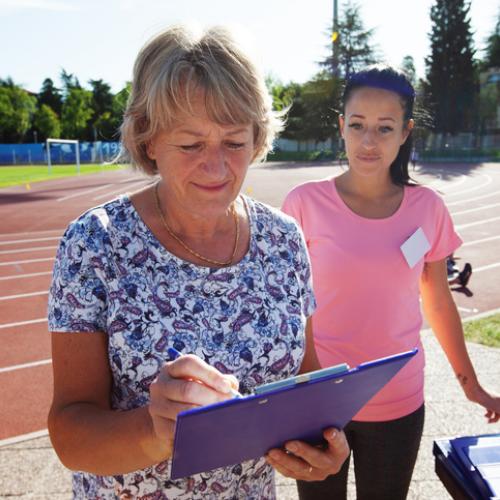Explore sample needs assessments, priority-setting documents, and resource models for conducting comprehensive legal needs assessments in service areas.

Identifying Community Legal Needs and Organizational Priorities
Conducting periodic, comprehensive legal needs assessments is crucial to providing legal services to legal aid-eligible populations and planning strategic resource allocation. The process also allows for direct client outreach, staff engagement, community input, and service provider insights. By engaging all of these stakeholders, LSC grantees can increase their visibility and identify barriers to justice.

Founded in 1908 to secure justice and protect the rights of the needy, the Legal Aid Society of Greater Cincinnati (LASGC) has a long history of engaging with the communities in Cincinnati and its outlying counties. Since the 1970s, the program has conducted regular civil legal assessments as a part of its strategic planning.
As part of its comprehensive, year-long needs assessment, which includes community meetings, surveys, data collection and review, and staff and board retreats, LASGC implemented an outreach— or listening tour — model to solicit community feedback.
Under the model, staff met with community members and members from nonprofits or organizations whose industry area — health care, education, or government, for example — would be conducive to forming a meaningful partnership. During the last needs assessment, LASGC staff interviewed more than 100 of these individuals in the greater Cincinnati community.
While the organization previously hired consultants to handle the interviews, they currently find value in facilitating these discussions and gathering data. This change—switching staff for consultants—has paid off tremendously.
First, by having an active, front-seat role in the listening tour model, LASGC staff have been able to develop their skills and are also better aligned with the organization’s mission and goals. For someone who works in legal services, it’s important to know how to develop a plan, articulate a goal, and establish a timeline—all components of project management. LASGC staff, regardless of whether they are a lawyer or a paralegal, now have this knowledge, and the organization is looking into a similar skills training for the technology and development staff.
Second, by altering the information-gathering method of the model from small group breakouts, where the conversation could easily be dominated by one or several people, to individual meetings, LASGC has received more high-quality input while also being more respectful of the interviewee’s time.
Third, the emphasis on skills development, combined with the overall positive results of the model, including the formation of strong joint programs and partnerships, have led to greater buy-in and collaboration between staff. Perhaps more than anything, a comprehensive and inclusive needs assessment process requires staff to be well-trained and on board—and that’s exactly the case at LASGC.
Legal Aid Chicago’s (LAC) 2022 comprehensive needs assessment provides a nuanced view of the civil legal challenges facing low-income communities in Cook County, Illinois. The assessment offers a holistic picture of unmet legal needs by employing multiple research methods and engaging both service providers and community members. LAC’s approach identified community members’ most pressing issues and revealed systemic barriers and demographic shifts that impact service delivery.
LAC’s research methodologies included:
- Literature review of 25 legal needs assessments from LSC grantees and other legal aid organizations
- Key informant interviews
- Focus groups with community members
- Web-based survey of service providers
- Analysis of Legal Aid Chicago’s internal case data
- Review of secondary data sources like U.S. Census data
Community, partner, service provider, and staff feedback were crucial for LAC’s understanding of resident civil legal needs. Throughout the assessment process, LAC engaged a high volume of stakeholders:
- 72 key informant interviews
- 40-plus participants across four community focus groups
- 350 valid survey responses from 195 different community organizations
- Nine internal group discussions with LAC staff, gathering nearly 130 perspectives
LAC’s needs assessment successfully captured the civil legal needs that low-income Cook County residents found most pressing:
- Housing issues, including evictions, affordable housing, and homelessness
- Family law issues, especially domestic violence, divorce, and child custody
- Public benefits access and appeals
- Immigration legal services
- Employment issues
- Consumer debt issues
- Criminal record expungement and reentry services
- Assistance for elderly residents and people with disabilities
Click below to read LAC’s complete needs assessment:
The Montana Legal Services Association (MLSA) conducted a comprehensive needs assessment from August 2020 through September 2021 to understand and address the legal challenges facing Native Americans across Montana. This initiative reflected MLSA’s commitment to serving its tribal populations and recognizes the unique challenges facing indigenous populations living in Montana. The assessment aimed to gather insights directly from those with deep experience in these communities to inform MLSA’s service delivery and resource allocation.
Due to the ongoing COVID-19 pandemic and its disproportionate impact on tribal nations, MLSA relied on phone or video interviews to capture information from tribal members living on each reservation. Below is a breakdown of the methodology MSLA used:
- Conducted 57 in-depth phone and video interviews
- 50 interviewees identified as members of tribal communities
- Interviewees included service providers, court personnel, school staff, and community leaders
- Represented all seven reservation communities in Montana and urban areas
- Incorporated quantitative ratings of specific legal issues
- Analyzed and overlaid feedback with U.S. Census data and tribal court records
Thanks to the invaluable information collected during the interviews, MLSA identified the most pressing legal needs facing tribal members in Montana:
- Housing availability, affordability, and discrimination
- Healthcare access and quality, particularly related to the Indian Health Service
- Lack of legal representation and difficulty navigating legal systems
- Family law matters
- Economic development issues
- Addressing historical and generational trauma related to legal problems
Click below to read MLSA’s full Native American Needs Assessment:
Community Legal Aid SoCal (CLA SoCal) undertook a comprehensive community needs assessment to better understand and address the legal challenges facing low-income residents in Orange County and Southeast Los Angeles County. By adopting a multilayered research approach, CLA SoCal gained a nuanced understanding of low-income residents’ legal needs, justice barriers, and improved service delivery opportunities.
CLA SoCal’s mixed-method approach to the needs assessment included community engagement and secondary research:
- Community needs survey in four languages (English, Spanish, Korean, Vietnamese)
- 32 focus groups and one-on-one interviews with community leaders and residents
- Secondary data from sources like the U.S. Census, local community reports, and court data
- Questions to interviewees about the prevalence of specific legal issues
CLA SoCal reached a wide representation of community members through these engagement efforts.
- 482 survey responses, including 441 from CLA SoCal’s service area
- 85 focus group participants and interviewees, including 32 community residents and 53 service providers
The residents CLA SoCal engaged revealed several pressing legal needs:
- Housing, including evictions, landlord-tenant issues, and the lack of affordable housing
- Healthcare access to services and issues with insurance coverage
- Difficulty navigating legal systems and the lack of affordable representation
- Family law issues
- Immigration
- Consumer issues, including debt and predatory lending
- Elder abuse and conservatorship issues
Click below to read CLA SoCal’s full community needs assessment.
To ensure that program priority areas accurately reflected community need, the Land of Lincoln Legal Assistance Foundation set priorities that incorporated an analysis of the results of its big legal needs assessment conducted in 2011 and its case statistics.
The legal needs assessment, which surveyed members of the legal community, social service providers, and low-income people in the service area, revealed that housing and income-related issues were the most important types of cases. However, case statistics showed that more than half of Land of Lincoln's resources were being allocated to family law. In order to balance the amount of time devoted to each case type, the 2013 priorities established minimum percentage times that must be devoted to each priority area of service.
Each priority below included goals and objectives:
- Income security
- Safe and affordable housing
- Health care
- Family safety and stability
- Consumer protection
- Utilities
- Quality education
- Protection of seniors and persons with disabilities
Land of Lincoln also established strategies for recruiting private bar and other volunteers, providing services to populations with special vulnerabilities, promoting race equity, and using grants from non-LSC funders.
In 2016, the Land of Lincoln conducted a comprehensive needs assessment, which examined the legal needs of senior clients in central and southern Illinois. Their report outlines the data collection methods, a summary of the raw data, and the findings and implications of the assessment.
Utah Legal Services developed a three-tier hierarchy addressing case service priorities to establish the organization's most important, moderately significant, and least critical case services.
Separate priority lists existed for:
- Core case service priorities
- Migrant farm worker program
- Native American program
- Seniors and elder law
- Pro bono program
Iowa Legal Aid's staff and board of directors conducted a priority-setting process, which included a staff committee, demographic research, research of emerging legal problems for low-income people, and collection of input from a wide variety of stakeholders. Surveys were administered to local advisory councils from each of the organization's offices; volunteer lawyers; former clients, including those with limited English proficiency; and the general public through a link to a survey on Iowa Legal Aid's website. The following priorities were adopted:
- Preserving safety and stability of individuals and families
- Preserving the home
- Maintaining or improving economic stability
- Obtaining necessary health care
- Preserving fundamental rights for populations with special vulnerabilities
- Obtaining assistance in emergency situations
- Ensuring access to advice and referral
- Increasing knowledge through legal education
- Expanding access to resources through partnerships
- Obtaining improved delivery of legal services
Legal Aid of Arkansas and Center for Arkansas Legal Services, with support from the University of Arkansas Clinton School of Public Service, conducted a statewide legal needs assessment to determine the civil legal needs of low-income Arkansans who are potentially eligible for legal aid services.
The authors conducted an extensive literature review to determine an appropriate model study and methodology so the study could respond to recent shifts in legal aid while still meeting LSC requirements.
To gather data from the low-income population, the study used three different approaches: 1) purchasing a mailing list of 7,500 randomly selected low-income Arkansans from U.S. Data Corporation in order to reach income-eligible potential clients; 2) randomly asking clients who called the hotlines to complete questionnaires, which were administered by the helpline staff; and 3) conducting focus groups within each of the state's four congressional districts to obtain qualitative feedback.
